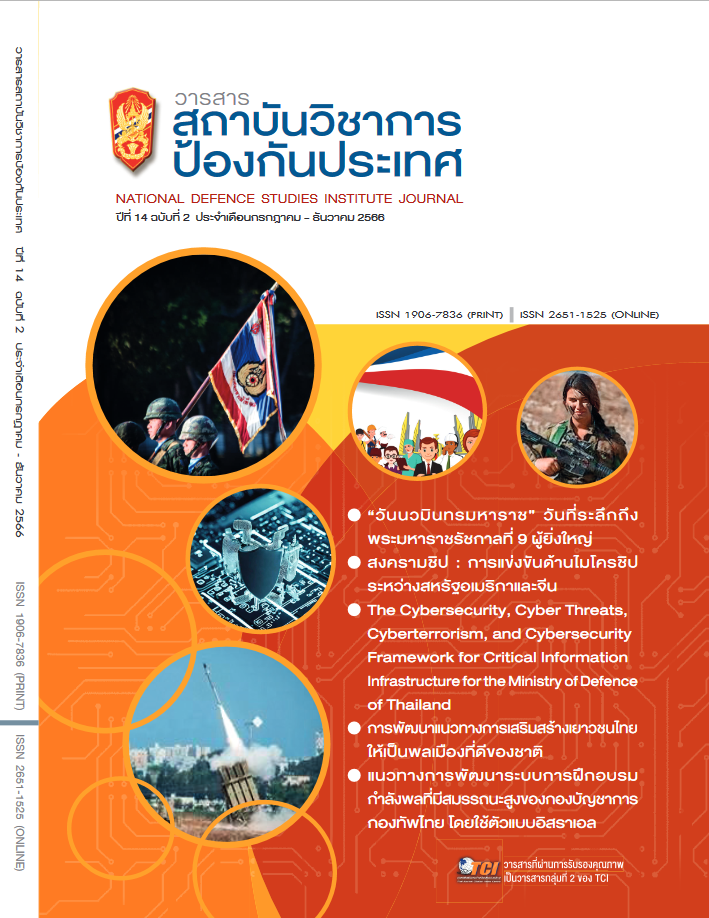The Influence of Psychological Well-being and Social Engagement on Subjective Well-being among Elderly Veterans in Bangkok
Main Article Content
Abstract
This research aims to investigate: 1) to assess the levels of psychological well-being, social engagement, and subjective well-being among elderly veterans, and 2) to examine the predictive influence of individual factors, psychological well-being, and social engagement on the subjective well-being of elderly veterans. The study sample group consisted of 370 elderly veterans in Bangkok by convenient sampling method and data was collected through questionnaires administered. The statistical analysis used included as percentages, mean values, standard deviations, and multiple regression analysis, using the enter method.
The findings of this study revealed that elderly veterans have psychological well-being (M = 4.05), social engagement (M = 4.15) and subjective well-being (M = 3.75) is at a relatively high level. Results of multiple regression analysis that psychological well-being (𝛽 = 0.430, p < .001) and social engagement (𝛽 = 0.340, p < .001) significantly predicted subjective well-being, demonstrating statistical significance (R2 = .485, p < .001). These results offer valuable insights for promoting subjective well-being among veterans within the War Veterans Organization of Thailand under Royal Patronage His majesty the King, related organizations, or other researchers interested in this area.
Article Details

This work is licensed under a Creative Commons Attribution-NonCommercial-NoDerivatives 4.0 International License.
The articles, images, tables, graphs, written content, and opinions published in this journal are solely those of the authors and do not necessarily reflect the views or positions of the National Defence Studies Institute or its academic affiliates.
References
กระทรวงสาธารณสุข, กรมสุขภาพจิต. (2562). แผนพัฒนาสุขภาพจิตแห่งชาติ ฉบับที่ 1 (พ.ศ. 2561-2580). สืบค้นเมื่อ 21 กรกฎาคม 2566, จาก https://www.dmh-elibrary.org/items/show/450
พัชรี ศุภดิษฐ์. (2551). อิทธิพลของการเปรียบเทียบทางสังคมและรายได้ต่อความสุขเชิงอัตวิสัย (ศิลปศาสตรมหาบัณฑิต). คณะจิตวิทยา จุฬาลงกรณ์มหาวิทยาลัย. กรุงเทพฯ.
มหาวิทยาลัยมหิดล, สถาบันวิจัยประชากรและสังคม และมูลนิธิสถาบันวิจัยและพัฒนาผู้สูงอายุไทย. (2563). สถานการณ์ผู้สูงอายุไทย พ.ศ. 2563. กรุงเทพฯ: บริษัท อมรินทร์พริ้นติ้ง แอนด์พับลิชซิ่ง จำกัด (มหาชน).
สมหมาย กุมผัน, โสภิณ แสงอ่อน, และพัชรินทร์ นินทจันทร์. (2559). ปัจจัยที่มีอิทธิพลต่อความว้าเหว่ในผู้สูงอายุ (วิทยานิพนธ์พยาบาลศาสตรมหาบัณฑิต). มหาวิทยาลัยมหิดล. กรุงเทพฯ.
สุชีรา สวนตะโก. (2559). แนวทางพัฒนาการให้การสงเคราะห์แก่ทหารผ่านศึก กรณีศึกษา การสงเคราะห์ด้านอาชีพ องค์การสงเคราะห์ทหารผ่านศึก (รัฐศาสตรมหาบัณฑิต). มหาวิทยาลัยธรรมศาสตร์. กรุงเทพฯ.
องค์การสงเคราะห์ทหารผ่านศึก ในพระบรมราชูปถัมภ์. (2566). การสงเคราะห์ขององค์การสงเคราะห์ทหารผ่านศึก. สืบค้นเมื่อ 3 พฤษภาคม 2566, จาก https://thaiveterans.mod.go.th/
อัจศรา ประเสริฐสิน, ทัชชา สุริโย, และปพน ณัฐเมธาวิน. (2561). สุขภาวะของผู้สูงอายุ : แนวคิดและปัจจัยที่เกี่ยวข้อง. วารสารสุขศึกษา, 41, 1-15.
Diener, E., Oishi, S., & Lucas, R. E. (2003). Personality, Culture, and Subjective Well-being: Emotional and Cognitive Evaluations of Life. Retrieved June 19, 2023 from https://www.researchgate.net/publication/11215086_Personality_Culture_and_Subjective_WellBeing_ Emotional_and_ Cognitive_Evaluations_of_Life
Diener, E., Wirtz, D., Tov, W., Kim-Prieto, C., Choi, D., Oishi, S., ... Biswas-Diener, R. (2009). New Well-being measures: short scales to assess flourishing and positive and negative feelings. Social Indicators Research, 143-156.
Gerritsen, D. L., Steverink, N., Frijter, D. H., Hirdes, J. P., Ooms, M. E., & Ribbe, M. W. (2008). A revised Index for Social Engagement for long-term care. Journal of Gerontological Nursing, 34(4), 40-48.
Gillbart, E. E., & Hirdes, J. P. (2000). Stress, social engagement and psychological well-being in institutional settings: Evidence based on the Minimum Data Set 2.0. Canadian Journal on Aging, 19(suppl), 50-66.
Kiely, D. K., & Flacker, J. M. (2003). The protective effect of social engagement on 1 year mortality in a long-stay nursing home population. Journal of Clinical Epidemiology, 56(5), 472-478.
Mor, V., Branco, K., Fleishman, J., Hawes, C., Phillips., C. Morris J., ...Fries, B. (1995). The structure of social engagement among nursing home residents. Journals of Gerontology: Series B: Psychological Sciences and Social Sciences, 50(1), 1-8.
Natetida Bunnag. (2564, 9 สิงหาคม). สุขภาวะทางจิตที่ดี ไม่เพียงมีประโยชน์ส่วนบุคคล แต่ยังช่วยลดค่าใช้จ่ายของรัฐด้านการดูแลสุขภาพด้วย. SDG MOVE. สืบค้นเมื่อ 6 มิถุนายน 2566, จาก https://www.sdgmove.com/2021/08/09/mental-wellbeing-curb-social-and-health-care-cost/
Ryff, C. D. (1995). Psychological Well-Being in Adult Life. Current Directions in Psychological Science, 4(4), 99-104.
Ryff, C. D., & Keyes, C. L. M. (1995). The Structure of psychological well-being revisited. Journal of Personality and Social Psychology, 64(4), 719-727.
Schreiner, A. S., Yamamoto, E., & Shiotani, H. (2005). Positive affect among nursing home residents with Alzheimer’s dementia: The effect of recreational activity. Aging & Mental Health, 129-134.
Verbeek, H., Zwakhalen, S. M. G., Rossum E. V., Ambergen, T., Kempen, G. I. J. M., & Hamers, J. P. H. (2014). Effects of small-scale, home-like facilities in dementia care on residents’ behavior, and use of physical restraints and psychotorpic drugs: A quasiexperimental study. International Psychogeriatrics, 26(4), 657-668.
Yoon, J. Y., and Kim, H. (2017). The Revised Index For Social Engagement in Long-Term Care Facilities: A Psychometric Study. The Journal of Nursing Research, 25(3), 216-223.
Zimmerman, S., & Cohen, L. W. (2010). Evidence behind The Green House and similar models of nursing home care. Aging Health, 6(6), 717-737.


